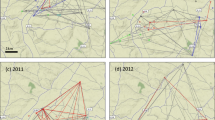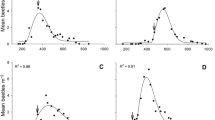Abstract
Biological control agents can be more effective if their populations are genetically diverse, particularly when the target invasive plant comprises a range of genotypes with different susceptibilities and occurs across various microclimates. We report on the use of an efficient approach to find, in the native range, diverse isolates of a rust fungus for biological control. An outdoor trap garden containing various clones of invasive European blackberry (Rubus fruticosus agg.) collected in Australia, each with a different DNA phenotype, was established in France. Within 4 weeks of establishment, the leaf-rust fungus Phragmidium violaceum was recovered from all clones in the garden. Molecular analyses of eight recovered and purified isolates of the fungus from the garden revealed that they were genetically distinct from each other and from isolates already present in Australia. These garden isolates also represented a subset of the population existing in Europe, when compared to isolates collected about 30 years ago. Two pathogenicity phenotypes were observed among the garden isolates in bioassays consisting of representative blackberry clones from Australia, and together the isolates were capable of infecting all clones. Results from host-specificity tests on key non-target plant species closely related to European blackberry concurred with previous findings that the leaf-rust fungus does not pose a threat to commercial blackberry cultivars and Rubus species native to Australia. The release and establishment of the garden isolates in Australia has potential to increase the genetic diversity and evolutionary potential of the leaf-rust fungus for more effective biological control.

Similar content being viewed by others
Abbreviations
- PCoA:
-
principal coordinate analysis
References
Ahlroth, P., Alatalo, R. V., Holopainen, A., Kumpulainen, T., & Suhonen, J. (2003). Founder population size and number of source populations enhance colonization success in waterstriders. Oikos, 137, 617–620.
Barrett, L. G., Thrall, P. H., Burdon, J. J., & Linde, C. C. (2008). Life history determines genetic structure and evolutionary potential of host-parasite interactions. Trends in Ecology and Evolution, 23, 678–685.
Bruzzese, E., & Field, R. P. (1985). Occurrence and spread of Phragmidium violaceum on blackberry (Rubus fruticosus) in Victoria, Australia. In E. S. Delfosse (Ed.), Proceedings of the VI International Symposium on Biological Control of Weeds (pp. 609–612). Ottawa: Agriculture Canada.
Bruzzese, E., & Hasan, S. (1986a). Host specificity of the rust Phragmidium violaceum, a potential biological control agent of European blackberry. Annals of Applied Biology, 108, 585–596.
Bruzzese, E., & Hasan, S. (1986b). The collection and selection in Europe of isolates of Phragmidium violaceum (Uredinales) pathogenic to species of European blackberry naturalized in Australia. Annals of Applied Biology, 108, 527–533.
Bruzzese, E., & Hasan, S. (1986c). Infection of Australian and New Zealand Rubus subgenera Dalibarda and Lampobatus by the European blackberry rust fungus Phragmidium violaceum. Plant Pathology, 35, 413–416.
Crawford, K. M., & Whitney, K. D. (2010). Population genetic diversity influences colonization success. Molecular Ecology, 19, 1253–1263.
Ellison, C. A., Evans, H. C., & Ineson, J. (2004). The significance of intraspecies pathogenicity in the selection of a rust pathotype for the classical biological control of Mikania micrantha (mile-a-minute weed) in Southeast Asia. In J. M. Cullen, D. T. Briese, D. J. Kriticos, W. M. Lonsdale, L. Morin, & J. K. Scott (Eds.), Proceedings of the XI International Symposium on Biological Control of Weeds (pp. 102–107). Canberra: CSIRO Entomology.
Evans, K. J., & Bruzzese, E. (2003). Life history of Phragmidium violaceum in relation to its effectiveness as a biological control agent of European blackberry. Australasian Plant Pathology, 32, 231–239.
Evans, K. J., Gomez, D. R., Jones, M. K., Oakey, H. & Roush, R. T. (2011). Pathogenicity of Phragmidium violaceum isolates on European blackberry clones and on leaves of different ages. Plant Pathology 60, 532–544.
Evans, K. J., Jones, M. K., Mahr, F. A., & Roush, R. T. (2000). DNA phenotypes of the blackberry biological control agent, Phragmidium violaceum, in Australia. Australasian Plant Pathology, 29, 249–254.
Evans, K. J., Jones, M. K., & Roush, R. T. (2005). Susceptibility of invasive taxa of European blackberry to rust disease caused by the uredinial stage of Phragmidium violaceum under field conditions in Australia. Plant Pathology, 54, 275–286.
Evans, K. J., Symon, D. E., & Roush, R. T. (1998). Taxonomy and genotypes of the Rubus fruticosus L. aggregate in Australia. Plant Protection Quarterly, 13, 152–156.
Evans, K. J., Symon, D. E., Whalen, M. A., Hosking, J. R., Barker, R. M., & Oliver, J. A. (2007). Systematics of the Rubus fruticosus aggregate (Rosaceae) and other exotic Rubus taxa in Australia. Australian Systematic Botany, 20, 187–251.
Evans, K. J., & Weber, H. E. (2003). The most widespread taxon of weedy blackberry in Australia is Rubus anglocandicans (Rosaceae). Australian Systematic Botany, 16, 527–537.
Giraud, T., Gladieux, P., & Gavrilets, S. (2010). Linking the emergence of fungal plant diseases with ecological speciation. Trends in Ecology and Evolution, 25, 387–395.
Gomez, D. R., Evans, K. J., Harvey, P. R., Baker, J., Barton, J., Jourdan, M., et al. (2006). Genetic diversity in the blackberry rust pathogen, Phragmidium violaceum, in Europe and Australasia as revealed by analysis of SAMPL. Mycological Research, 110, 423–430.
Gomez, D. R., Evans, K. J., Baker, J., Harvey, P. R., & Scott, E. S. (2008). Dynamics of introduced populations of Phragmidium violaceum and implications for biological control of European blackberry in Australia. Applied and Environmental Microbiology, 74, 5504–5510.
Hasan, S., Chaboudez, P., & Espiau, C. (1995). Isozyme patterns and susceptibility of North American forms of Chondrilla juncea to European strains of the rust fungus Puccinia chondrillina. In E. S. Delfosse & R. R. Scott (Eds.), Proceedings of the VIII International Symposium on Biological Control of Weeds (pp. 367–373). Melbourne: CSIRO Publishing.
Jackson, E. W., Obert, D. E., Chang, J., Avant, J. B., & Bonman, J. M. (2008). Detached-leaf method for propagating Puccinia coronata and assessing crown rust resistance in oat. Plant Disease, 92, 1400–1406.
Keiper, F. J., Hayden, M. J., Park, R. F., & Wellings, C. R. (2003). Molecular genetic variability of Australian isolates of five cereal rust pathogens. Mycological Research, 107, 545–556.
Mahr, F. A., & Bruzzese, E. (1998). The effect of Phragmidium violaceum (Shultz) Winter (Uredinales) on Rubus fruticosus L. agg. in south-eastern Victoria. Plant Protection Quarterly, 13, 182–185.
Molecular Ecology Resources Primer Development Consortium. (2010). Permanent Genetic Resources added to Molecular Ecology Resources Database 1 December 2009–31 January 2010. Molecular Ecology Resources, 10, 576–579.
Morin, L., Adair, R., Aveyard, R., Evans, K., Gomez, D., Lester, J., et al. (2008). National blackberry biological control program in partnership with the community. In R. D. van Klinken, V. A. Osten, F. D. Panetta, & J. C. Scanlan (Eds.), Proceedings of the 16th Australian Weeds Conference (pp. 344–346). Brisbane: Queensland Weeds Society.
Morin, L., Evans, K. J., & Sheppard, A. W. (2006). Selection of pathogen agents in weed biological control: critical issues and peculiarities in relation to arthropod agents. Australian Journal of Entomology, 45, 348–364.
Parker, I. M., & Gilbert, G. S. (2004). The evolutionary ecology of novel plant-pathogen interactions. Annual Review in Ecology, Evolution and Systematics, 35, 675–700.
Peakall, R., & Smouse, P. E. (2006). GENALEX 6: genetic analysis in Excel. Population genetic software for teaching and research. Molecular Ecology Notes, 6, 288–295.
Pei, M. H., Ruiz, C., Bayon, C., & Hunter, T. (2004). Rust resistance in Salix to Melampsora larici-epitea. Plant Pathology, 53, 770–779.
Prentis, P. J., Sigg, D. P., Raghu, S., Dhileepan, K., Pavasovic, A., & Lowe, A. J. (2009). Understanding invasion history: genetic structure and diversity of two globally invasive plants and implications for their management. Diversity and Distributions, 15, 822–830.
Ritz, C. M., Maier, W. F. A., Oberwinkler, F., & Wissemann, V. (2005). Different evolutionary histories of two Phragmidium species infecting the same dog rose hosts. Mycological Research, 109, 603–609.
Scott, J. K., Jourdan, M., & Evans, K. J. (2002). Biological control of blackberry: progress towards finding new strains of the rust fungus, Phragmidium violaceum. In H. Spafford Jacob, J. Dodd, & J. H. Moore (Eds.), Proceedings of the 13th Australian Weeds Conference (pp. 418–421). Perth: Plant Protection Society of WA Inc.
Smouse, P. E., & Peakall, R. (1999). Spatial autocorrelation analysis of multi allele and multi-locus genetic micro-structure. Heredity, 82, 561–573.
Twizeyimana, M., Ojiambo, P. S., Ikotun, T., Paul, C., Hartman, G. L., & Bandyopadhyay, R. (2007). Comparison of field, greenhouse, and detached-leaf evaluations of soybean germplasm for resistance to Phakopsora pachyrhizi. Plant Disease, 91, 1161–1169.
Villaréal, L. M. M. A., Lannou, C., de Vallavieille-Pope, C., & Neema, C. (2002). Genetic variability in Puccinia striiformis f.sp. tritici populations sampled on a local scale during natural epidemics. Applied and Environmental Microbiology, 68, 6138–6145.
Acknowledgments
We thank John Lester, Joel Armstrong, José Serin and Sylvie Richarte (CSIRO Ecosystem Sciences), and Midori Jones (formerly University of Adelaide) for technical assistance. We are also grateful to the following people who assisted us in locating various species for the host-specificity tests, provided plants/cuttings or kindly accommodated our needs: Graeme McGregor (Institute for Horticultural Development), Phil Rowe (Australian Rubus Grower Association), Heather Van De Ven (Berry Plant Suppliers), Rhonda Serpell (Serpell’s Berries), Brialey and Karen Meeuwissen (Nerrigundah Berries Pty. Ltd.), Tim Rudman (DPIWE, Tasmania), Jennie Whinam (Park and Wildlife Service, Tasmania), Tony Bean (Queensland Herbarium) and John Hosking (Industry & Investment New South Wales). Financial support from the respective organisations of the authors, the University of Adelaide, the former Cooperative Research Centre for Australian Weed Management, the Department of Agriculture and Food, Western Australia and the Department of Environment and Conservation, Western Australia is gratefully acknowledged.
Author information
Authors and Affiliations
Corresponding author
Rights and permissions
About this article
Cite this article
Morin, L., Evans, K.J., Jourdan, M. et al. Use of a trap garden to find additional genetically distinct isolates of the rust fungus Phragmidium violaceum to enhance biological control of European blackberry in Australia. Eur J Plant Pathol 131, 289–303 (2011). https://doi.org/10.1007/s10658-011-9808-0
Accepted:
Published:
Issue Date:
DOI: https://doi.org/10.1007/s10658-011-9808-0




